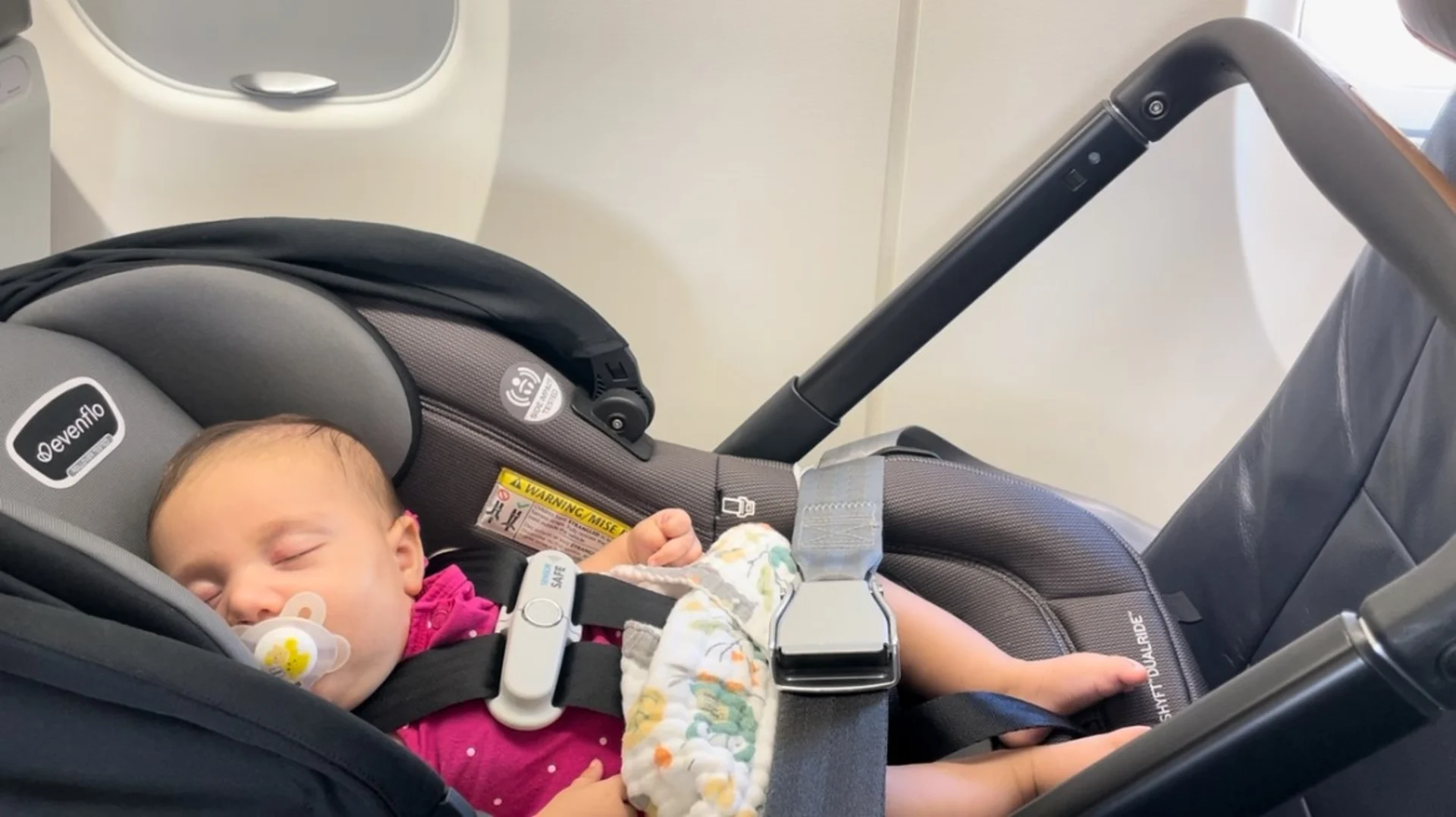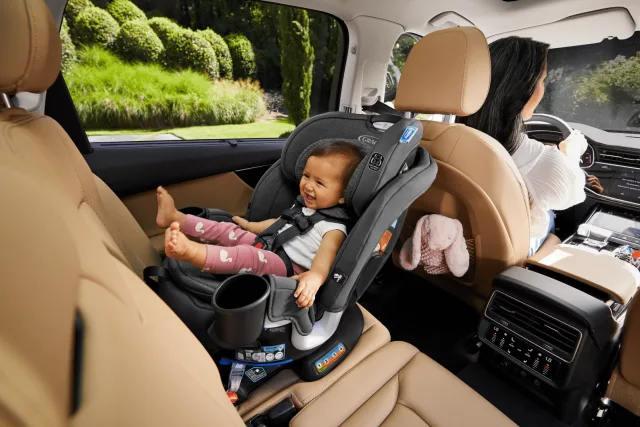Traveling with newborns is definitely an adventure especially air travel! Most of the time, if you’re considering flying with a newborn, it’s out of necessity, which can add to the stress. Whether you’re completing an adoption, visiting an elderly family member, moving across the country, or just bravely vacationing with your little one, flying with newborns is a whole new world.
Newborns are delicate and unpredictable, which can make traveling with them a real challenge no matter the mode of transportation. In the first few weeks, babies typically haven’t developed clear habits or preferences, leaving parents with little to rely on to keep them calm and content. And even if you do start to recognize patterns, newborns change rapidly, so what soothes them one day might not work the next. Still, despite all the uncertainty, peaceful travel with a newborn is absolutely possible.
When Can Newborns Fly On Airplanes?
In this post, we’re going to discuss whether or not it’s safe to fly with a newborn and provide some tips to keep your trip as hassle-free as possible. It’s all about planning, expectations, mindset, and having the right gear. Let’s get into it!
Can Newborns Fly On Airplanes?
Yes! Newborns can fly on airplanes even if they don’t yet have a birth certificate or social security card. However, international travel would be difficult since it’s required for newborns to have a passport, which typically takes a few weeks to receive.
How Soon Can A Newborn Fly On An Airplane?
Most airlines allow newborns as early as 2-7 days old, so most people can be on their way shortly after they’re discharged from the hospital. However, most pediatricians will recommend you wait 5-6 weeks, if possible.

How To Fly With A Newborn
Think twice about international travel.
As we mentioned, consider when your international trip with your newborn is a true necessity. Getting a passport typically takes several weeks, and even if you're cleared to go, the long car seat ride, potential exposure to illness, and overall travel stress can be a lot on a new baby!
Check the newborn policy of each airline.
Every airline will have different requirements and standards for their newborn policy, so read all the available information before you book your trip!
Take an airplane travel class.
There’s a lot to figure out when flying with kids, and overlooking even small details can lead to unnecessary stress and hiccups along the way. That’s why taking a course like our Safe in the Sky can make such a big difference it helps you feel confident, calm, and ready for anything your trip throws at you!
Here’s everything that’s included in our travel course:
- Covers domestic and international travel
- Comprehensive guide on preparing for your trip so you don’t overlook anything
- Security and airport game plans
- Boarding and deplaning process, tips and tricks
- Must have gear and gadgets
- Full database of best car seats for airplane travel
- Installation on the airplane how-to
- Private and very active Facebook group where you can brainstorm and gain insight from others who have traveled with car seats
- Access for as long as we host the course!
Choose the flight time wisely and try to go direct.
When picking your flight times, consider your baby’s current schedule. We know that newborns may not have a super predictable routine at this point, but do your best to choose a flight where your baby sleeps most of the way. It’s one of the best hacks to travel with a baby successfully! You’ll also want to find a direct flight if possible to avoid hassles like re-installing the car seat and moving luggage.
Purchase a seat for your newborn.
Technically, children under the age of 2 can ride on your lap for free. However, this isn’t safe in extreme turbulence or a rough landing. Your little one could be at risk of serious injury if they’re not secured in a car seat.
Plus, your child will not only be safer in their own car seat, but they’ll also be more comfortable. This way, you won’t need to hold your newborn the entire flight, allowing you to maybe get some rest, too!
Opt for bulkhead seats or window seats when possible.
Since you'll need to install a car seat, having extra space is key. Window seats are typically required for car seat installation, as they prevent the seat from blocking other passengers during an emergency. Bulkhead seats (the rows directly behind partitions) offer the most extra legroom, but be sure to confirm you’re allowed to put a car seat there. But in some cases, these seats may have inflatable seat belts which will not work with infant seats.
Also be sure to avoid exit rows, because children under 15 are not allowed to sit there at all. These seats are reserved for passengers capable of assisting in an emergency, so if you’re traveling with a newborn, you’d be reassigned to a different seat.
Confirm flying is safe with your pediatrician.
Though flying may be allowed as early as 2 days old, your pediatrician may advise against it. The high altitude could exacerbate heart or lung problems or irritate ear infections and congestion. So, if your newborn is sick or has any ongoing health problems, flying may be unsafe or too uncomfortable for your little one. Ask your pediatrician if it’s a good idea to fly before you take off.
Bring the hospital-issued birth record or a doctor’s note.
Your new baby will likely not have a birth certificate or social security card by the time you leave. However, they do need identification! Bring the hospital-issued birth record or a doctor’s note that confirms the birth date if you don’t have one of the other forms of ID. This is what you’ll use to get through security.
Be strategic about what you pack in your carry-ons.
What you pack in your carry-on and personal bags really matters when you're flying with a newborn. You’ll want to bring extra clothes, plenty of diapers, feeding supplies, and anything else you might need in case things don’t go as planned. In this case, it’s totally okay to overpack. Better safe than sorry! The last thing you want is to run out of diapers while you’re stuck on the runway or taxiing forever after landing. So, pack plenty!
And, don’t forget TSA’s usual liquid rules don’t apply to breast milk or formula. You’re allowed to bring a “reasonable quantity” for your trip and you get to decide what’s reasonable. Most TSA agents won’t give you a hard time, especially when it’s clearly for your baby.
Bring your car seat on the plane.
As we mentioned earlier, bringing your child’s car seat on the plane with you should be non-negotiable. In fact, the Federal Aviation Administration (FAA) recommends that young children should all be in an approved child restraint system (CTS) for the safest ride!
Beyond that, checking a car seat and sending it through TSA and baggage handling can lead to damage sometimes as severe as what you'd see in a car crash. To get your seat safely to your destination, it should be with you at all times.
So, bring your car seat with you and install it on the plane. Here’s how to install the car seat on the plane easily using the seat belts:
But, before you drag your car seat to the airport with you, make sure it’s an FAA-approved car seat. Most car seats will be approved for use on airplanes, but it’s wise to check, because if your seat has a load leg or rotating feature, it’s less likely to be FAA-approved. And, even if your car seat is FAA-approved, if it’s heavy or bulk, you may want to purchase a lightweight seat specifically for travel. Here’s our favorite car seats for airplane travel.
Only check your stroller if you have to.
Just like baggage handling may cause damage to your car seat, it may damage your stroller, too. If you can, opt for a stroller that’s compact enough to fit in the overhead bin like the Ergobaby Metro+ or the Bugaboo Butterfly. You can find more travel-friendly strollers with our Stroller Finder Tool.
Take advantage of family boarding.
Most airlines offer family boarding, which allows parents with young children to get on the plane early to install car seats and get situated. We recommend you take advantage of this offer so you have lots of extra time to get things ready before other passengers crowd in.
Wipe everything down with disinfectant.
Germ exposure is a big concern when flying with a newborn. Their immune systems are still developing, and with all that recirculated air in a tight space, flying can increase the risk of picking up something. So before you settle in, take a minute to wipe everything down with disinfectant.
Bring plenty of wipes and clean any surfaces you or your baby might touch tray tables, armrests, seat belts, window panels, and even the seatback screen. A little prep goes a long way in keeping your baby healthy while traveling.
Be kind to yourself and don’t be afraid to ask for help.
Babies cry sometimes. Especially newborn babies. Most passengers are going to be pretty understanding. Be kind to yourself even if things don’t go as planned, and don’t be afraid to ask the flight attendants for help. That’s what they’re there for!
Make flying with your newborn safer and easier with these tips!
Flying with a newborn isn’t easy but it is doable. With the right mindset, a little prep, and a whole lot of grace for yourself, you can make it work. Whether you’re flying across the country or across the ocean, just remember that you know your baby best. Trust your instincts, lean on these tips, and take it one step (or one flight) at a time.
For more on traveling safely and successfully with a newborn, check out these posts:
- Safe Airplane Travel
- What You Need to Know About Traveling with a Newborn on a Plane
- Can You Swaddle a Baby in a Car Seat?
- The Best Car Seats for Preemies
As an Amazon Associate, Safe in the Seat earns from qualifying purchases.






